Click above for a high-res gallery.
With excursions in light aircraft, aerobatic planes, commercial jets, and helicopters already under our belt, we jumped on Goodyear's invite to take a flight in one of its three blimps stationed (or should we say tethered) in North America. The world's largest tire company has been flying blimps for more than 80 years. Used as a stable camera platform, or simply for advertising, the giant silver balloons have safely carried countless passengers over the decades. Follow the jump to read Autoblog's first review from the gondola of a lighter-than-air dirigible.
All photos copyright Michael Harley / Weblogs Inc.
The Goodyear blimp is technically defined as a "dirigible" (a lighter-than-air aircraft that can be steered). While it may appear to be remarkably similar in outward appearance to the famous, and ill-fated, German Zeppelin Hindenburg, that would simply be an 'apples to oranges' comparison. The Hindenburg was a "rigid" dirigible with fabric stretched over a metal framework. Filled with bags of hydrogen, the buoyant and highly flammable gas contributed to its fiery destruction in 1937. The Goodyear blimp, on the other hand, is a "non-rigid" dirigible – essentially a giant balloon without any internal support. If the gases inside the Goodyear blimp were to completely escape, it would deflate into a pile of rubberized fabric. More importantly, especially where safety is concerned, Goodyear's blimps are filled with inert non-flammable helium.
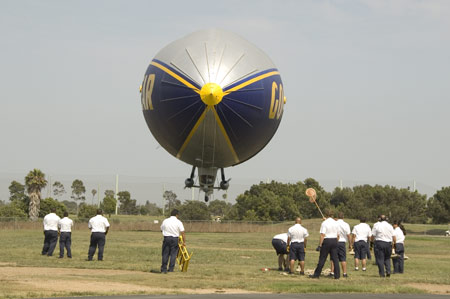
The basic technology behind blimp construction has changed little in more than 100 years. All blimps contain lighter-than-air gases within their "envelope," or visible outer skin, to lift the blimp and its payload above the ground. On the Goodyear blimp, the familiar silver and blue envelope containing helium is made from a durable two-ply neoprene-impregnated polyester fabric (blanketed, in a unique fashion, with over 165,000 LEDs for advertising). While all blimps operate in a similar manner, a cut-away view of the Goodyear blimp reveals two smaller air bags, or "ballonets," within the envelope. These bags, filled with outside air, are easily expanded or contracted to change the lift characteristics of the blimp. As the pilot forces air into the ballonets they grow in size within the envelope. This displaces the light helium and replaces it with the heavier outside air. In turn, this reduces lift causing the blimp to descend. As the gases within the blimp are at very low pressure (less than one psi above the ambient air), the pilot is able to use forced air, captured by scoops located just aft of the propellers, to inflate the ballonets to descend. When air is dumped from the ballonets, the helium expands again and lift is restored. The entire process is done manually by the pilot who pulls on cables located just above the windscreen.
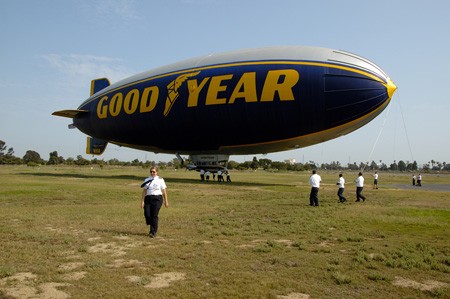
The pilot and passengers on the Goodyear blimp ride in the enclosed gondola under the envelope. It is hung from a set of steel cables that pass through the middle of the gas bag and are attached to the top of the blimp -- in effect the passenger compartment is suspended from the top, not merely stitched to the bottom of the envelope. Motivating the 192-foot-long Goodyear blimp is a pair of air-cooled Lycoming aircraft engines bolted to the side of the gondola. Each rated at 210 horsepower, they can spin their constant-speed twin-blade props through the air fast enough to propel the blimp upwards of 50 mph. Of course, that's assuming there's no headwind...
While the Goodyear blimp contains about 12,840 pounds of "material" (fabrics, engine, rigging, etc...), it weighs nothing in the air, and at most a couple hundred pounds when sitting on terra firma. It's the sheer size of the blimp -- a giant balloon blowing in the wind -- that makes it a handful on the ground. To address the issue, Goodyear employs a team of handlers (aka human ballast) to manhandle the blimp on the ground. A half-dozen handlers (who could moonlight as bouncers) grab the nose lines and another half-dozen hang on the gondola when it touches down. Passengers exit and enter in pairs to keep the weight relatively constant. It's a well-orchestrated team that turns the blimp around after each flight in just minutes.
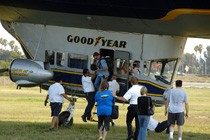
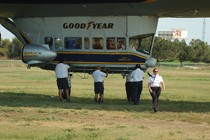
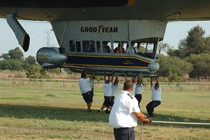
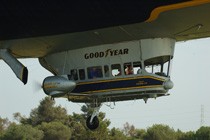
Once helped up the stairs and on board, the cabin is surprisingly roomy. All of the Goodyear blimps seat seven in normal "passenger" configuration (one pilot and six passengers). Of course, the seats can be replaced with camera/video equipment when the airship covers sporting events, which is quite common. With no seatbelts to speak of, and an interior cabin height of more than six feet, moving around was easy. The windows, many of them wide open, are large and angled so you can see nearly directly down. Passengers wear headphones for noise and communication when flying in the blimp. With the engines mounted on pods just a yard or two from the passenger cabin, the drone isn't deafening, but it can be bothersome after time.
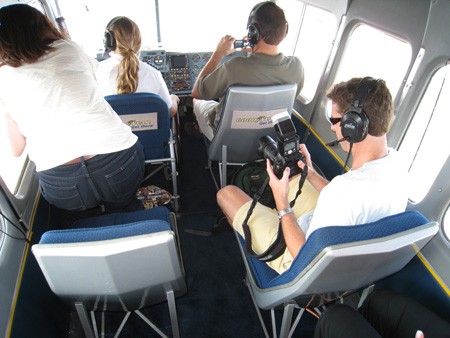
Takeoff is exhilarating. While a heavier-than-air machine needs to create lift by forcing air over a lifting surface (whether that be a wing, propeller, or turbine blade), a lighter-than-air machine can rise off the ground without any forward speed whatsoever. To get the blimp airborne, the pilot dumps the outside air from the ballonets. The pitch of the blimp is adjusted to a nose-high attitude (by taking more air from the front ballonet) and throttle is applied. Initial climb-out is steep -- nearly a 45 degree angle -- at a rate of about 500 ft/min. Gravity, much more than accelerative g-forces, pushes you hard into your seat, and the earth slowly moves away.
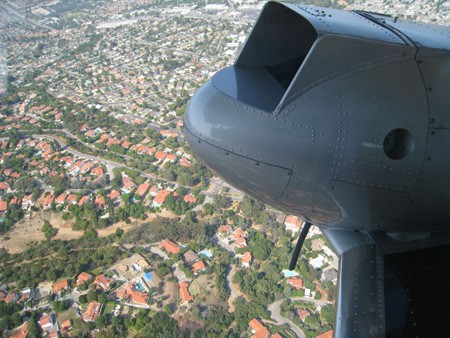
The maximum altitude for the Goodyear blimp is generally 7,500 to 10,000 feet, depending on the specific model. As it gains altitude the gases within the envelope expand. Since the skin of the blimp isn't designed to be flexible, special valves will dump the gas to protect the blimp if the pressure is too high. The Goodyear Blimp doesn't carry any additional compressed helium on board, so any gas lost to high altitudes cannot be replaced when the blimp returns to lower elevations and the blimp will sink. In general, the pilot will balance the gases within the envelope to keep the blimp cruising at an altitude of 1,500 ft. above the Earth, at an unhurried speed of 30-35 mph. It's the best compromise to keep noise levels low on the ground, yet still keep the electronic signage visible to onlookers up to one mile away.
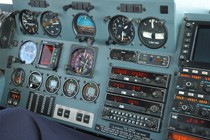
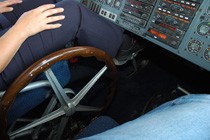
Loaded with flight instrumentation familiar to any pilot, the cockpit is impressively busy for such a simple aircraft. A single pilot flies the blimp with three primary controls: throttle, elevator wheel, and the rudder pedals. The throttle, controlling the engines and is primarily kept at one setting during the flight. The wooden elevator wheel, located between the front seats, controls the up and down motion of the blimp, while the rudder pedals, one under each foot, control the direction right and left. Like piloting a ship, the controls are moved in an exaggerated fashion, and then moved back into a neutral position before the maneuver is completed. The blimp responds lazily to the barn-door sized control surfaces, and often requires additional control inputs to keep it steady. Unlike a fixed-wing aircraft, the Goodyear blimp may gain (or lose) altitude while maintaining level flight as it rides thermals, air currents, and drafts. The pilot is constantly watching the rate-of-climb indicator, and the altimeter, to keep it level. From the passenger seat it's rather amusing watching the pilot spin the elevator wheel, push full rudder, and then wait through the delay as the mammoth slowly responds.
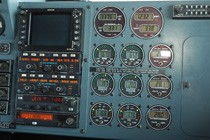
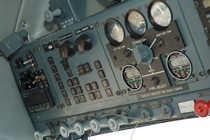
Once airborne, and at "cruising altitude," the blimp rides amazingly smooth. Unlike a commercial jet, light plane, or helicopter, the Goodyear blimp is rather immune from abrupt turbulence. The sheer mass of the airship, and its slow speed, allow the inflated envelope to absorb most of the turbulence. Our trip took us across the expansive Los Angeles basin, from Carson to Long Beach, and back. It was less than twenty miles, but at our leisurely pace it took a full hour.
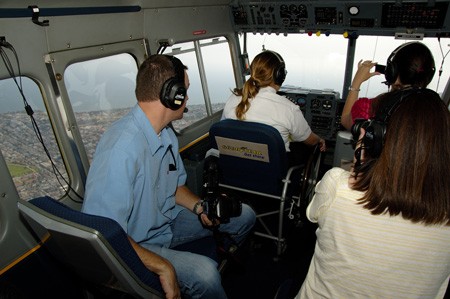
For the most part, the only "flying" sensation we felt was the slight rocking as the airship reacted to the wind. At one point the nose slowly pitched upward as we hit a thermal, but it was hardly considered abrupt. As everything seemed to happen in slow motion, we could simply move about the cabin during the flight without fear of being knocked off our feet. With the windows wide open, and gentle 30 mph breezes blowing by (the pusher props are behind the cabin), you could easily lean out the window, wave, and take pictures. The sensation is like being on the edge of a tall building's roof on a breezy day.
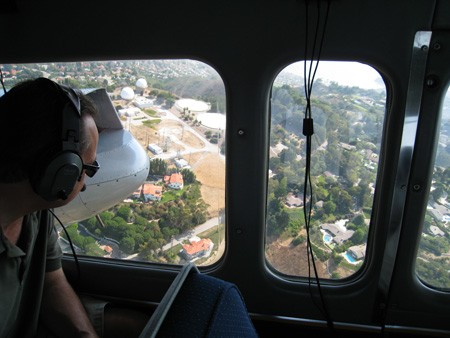
In defiance of other motorized flying machines, the Goodyear blimp does not "bank" into corners either. With the heavy gondola and engines slung on the underside, it turns nearly flat. Passengers needn't worry about flying out of their seats either -- in a maneuver similar to "drifting" a car, the airship will skid across the sky until it is ready to assume the next heading. Piloting a blimp requires learned intuition that comes from years of experience.
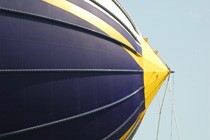
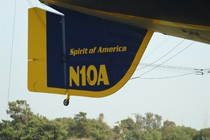
Landing wasn't as exhilarating as the take-off, but it certainly was interesting. With our landing zone clearly in view hundreds of feet below, it was apparent that the ground handlers weren't ready for our final descent. Our pilot abruptly cut the throttles and we just hung there... frozen in mid-air with a nose-down attitude. To someone used to fixed-wing circling "holding patterns" as the tower clears the runway, this was eerie but surprisingly effective. We actually started to drift backwards with the wind before the engines were spooled-up again for our landing!
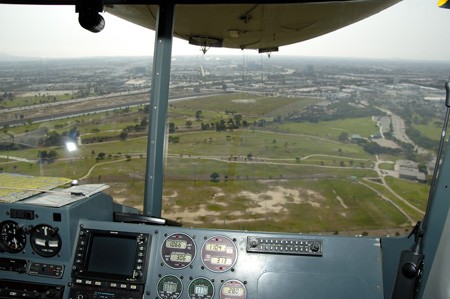
In preparation for landing, the pilot will trim the gases within the blimp so that it descends 50-100 pounds "heavy," and will drop the nose at a steep angle. (While it can just drop straight down if the ballonets are emptied, this approach allows the pilot to keep air moving over the control surfaces.) As the ground approaches, the dual mooring lines dangling down from the nose are grabbed by the handlers first. They move the giant balloon into position as more handlers grab hold of the gondola to hold it down for the next group of lucky passengers to board...
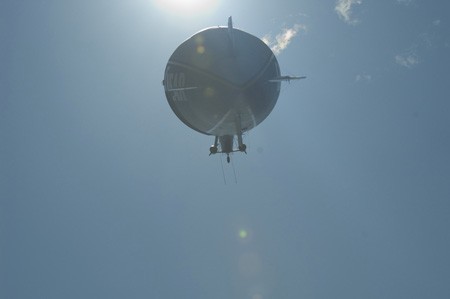
The Goodyear blimp is a stretch from our usual "In the Autoblog Garage" contribution, but there is a legitimate tie-in. As the automotive industry is reeling from volatile fuel prices, Goodyear is on a campaign to remind motorists to check their tire pressures monthly. According to Goodyear, running the proper tire pressure will increase fuel economy by up to three percent, maximize tire life, and retain optimal vehicle handling characteristics. Goodyear wants customers to develop a conditioned response to their highly visible blimps and immediately associate them with checking their own tire pressure. It's not too much of a spin when you consider that the same physics keeping the Goodyear blimp inflated so it can fly through the sky are at work keeping your tires inflated, and your vehicle safely on the road.
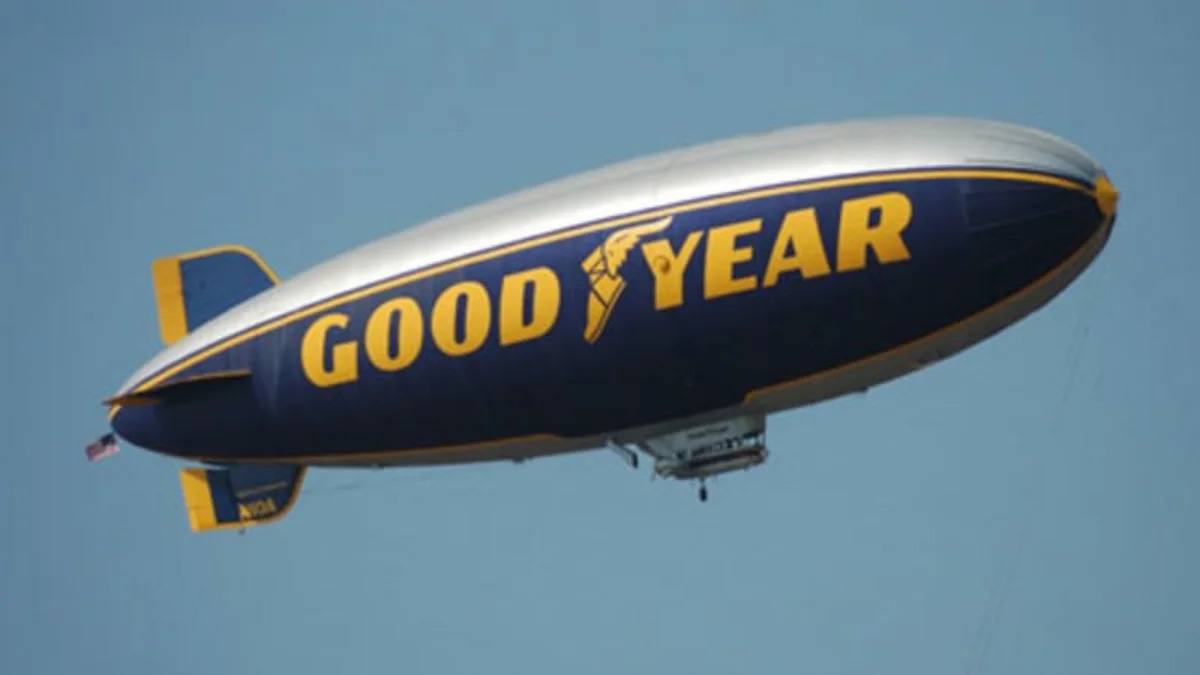

Sign in to post
Please sign in to leave a comment.
Continue